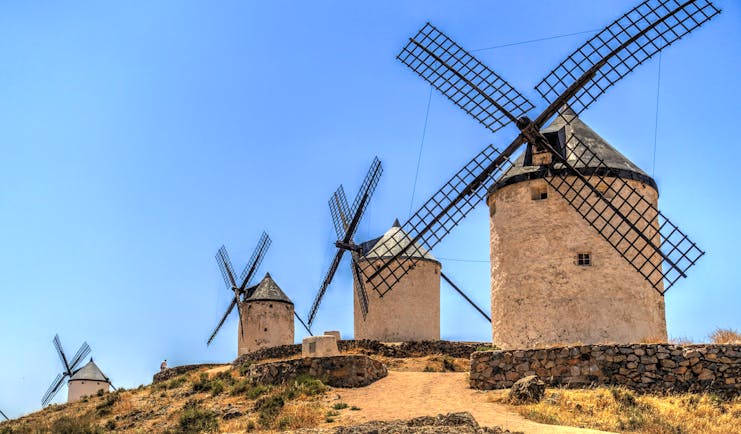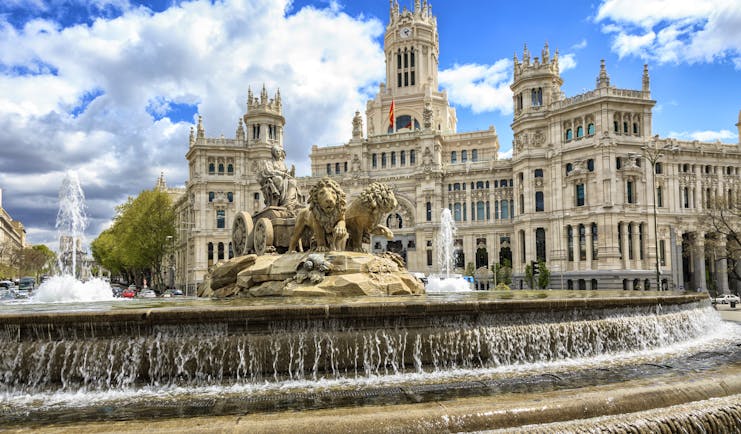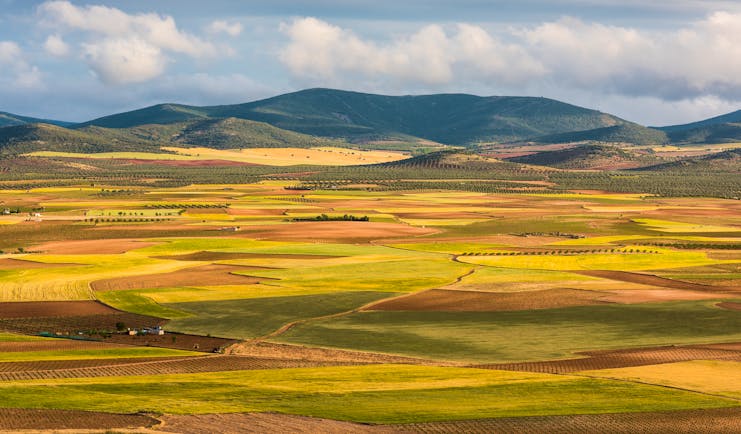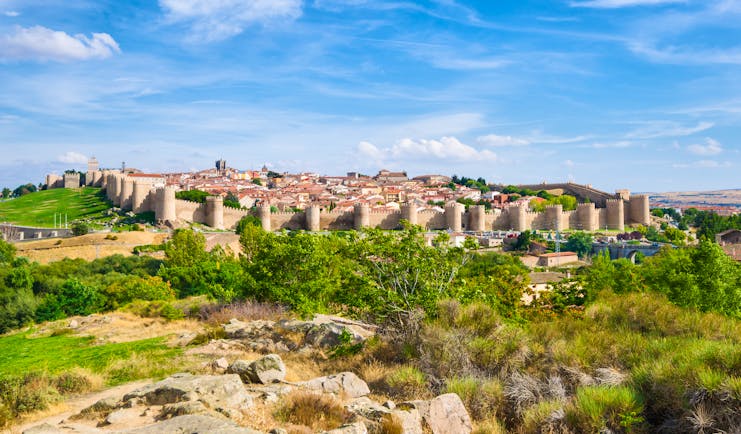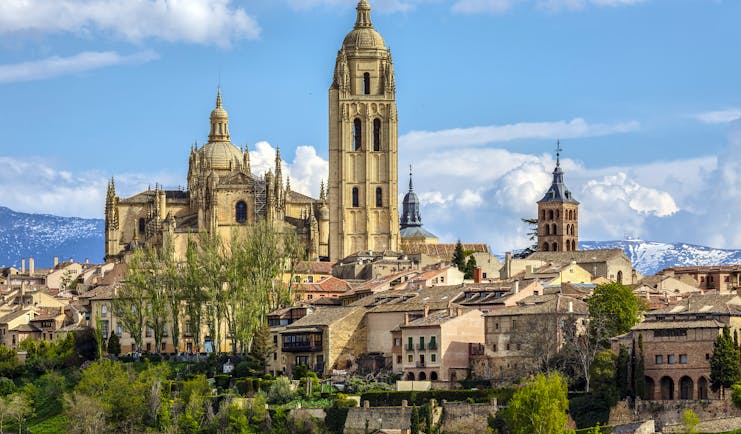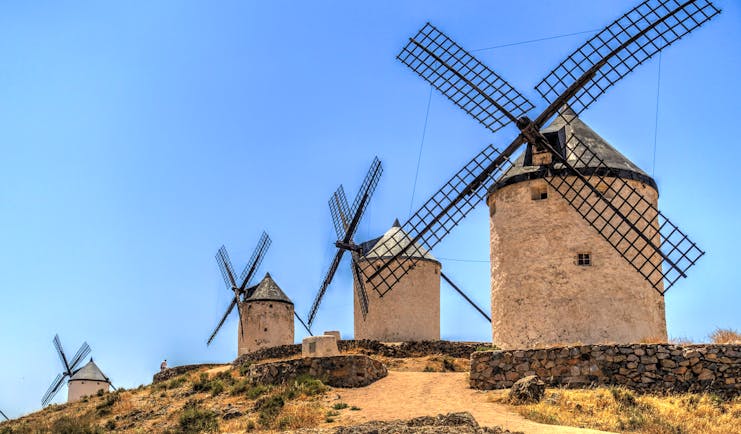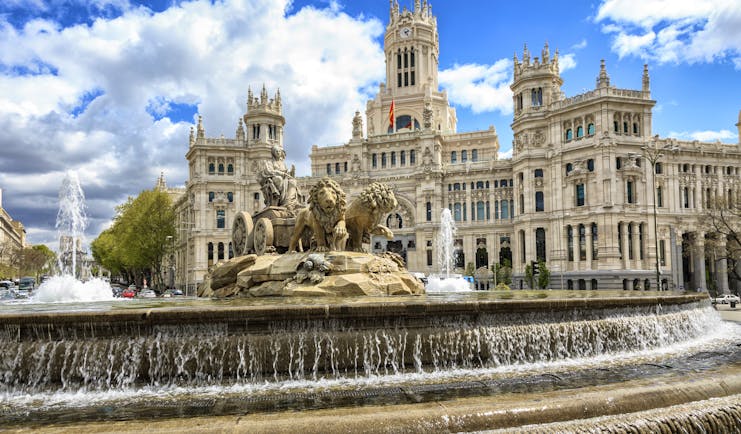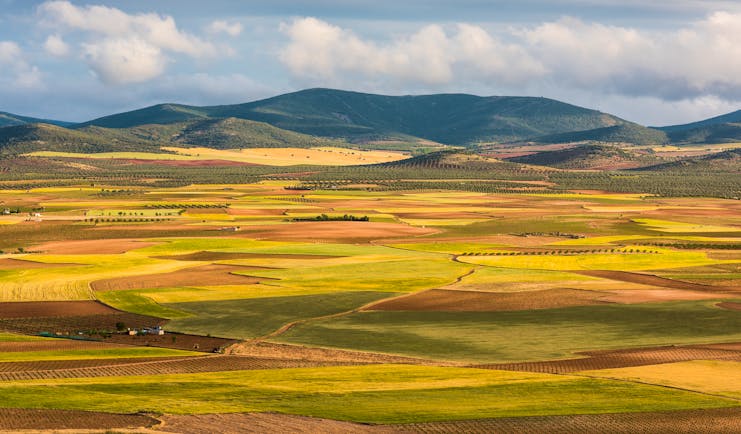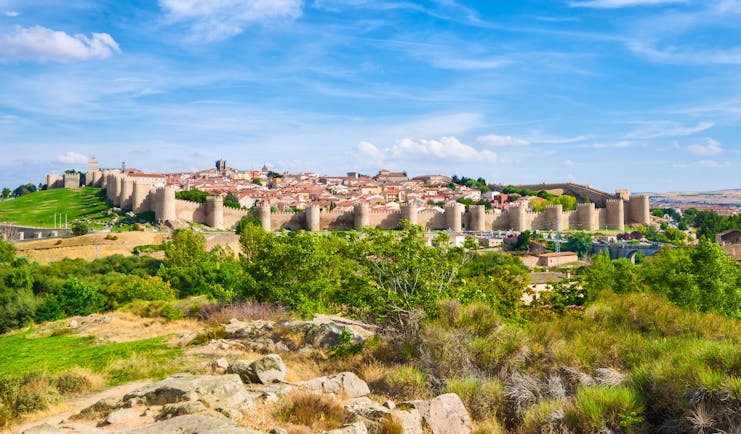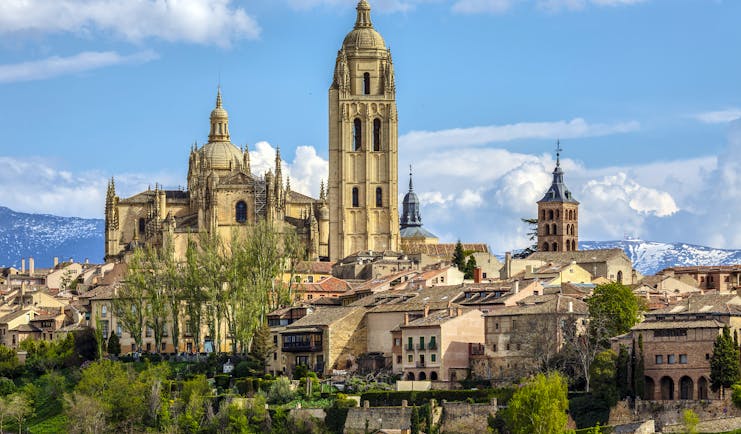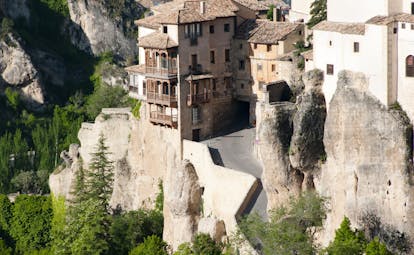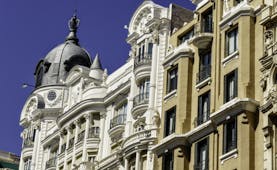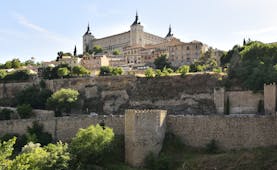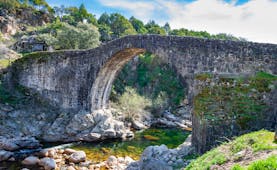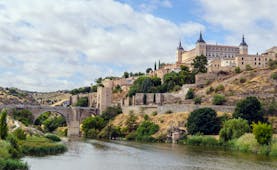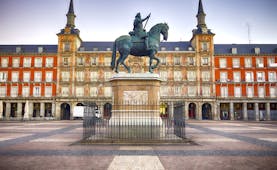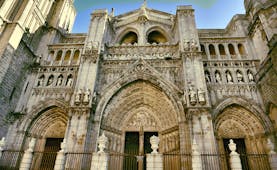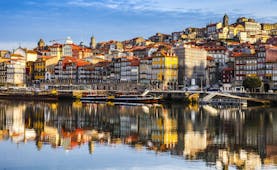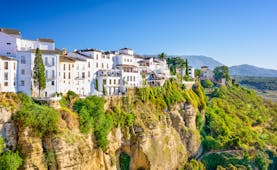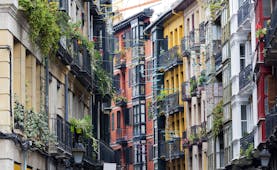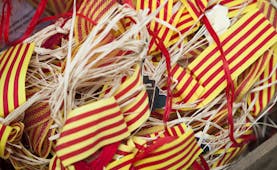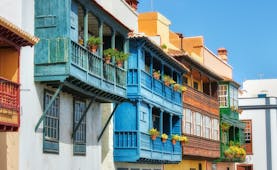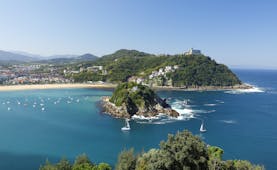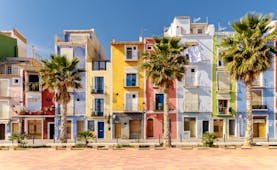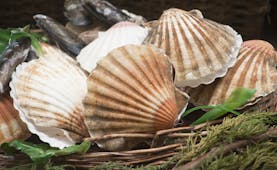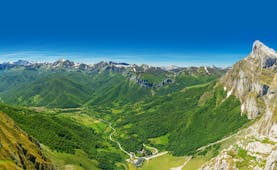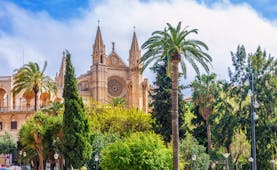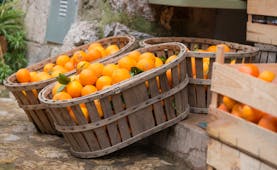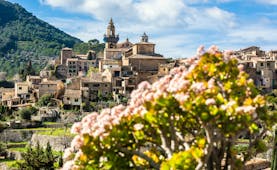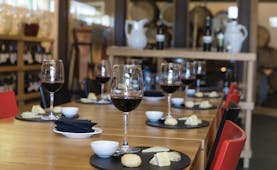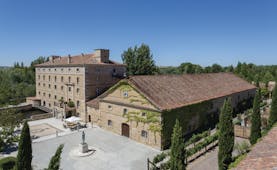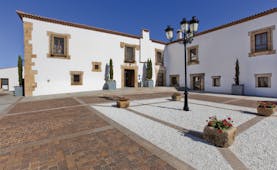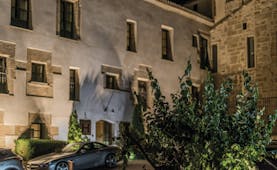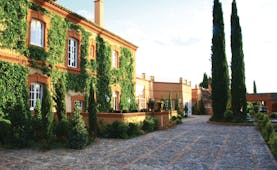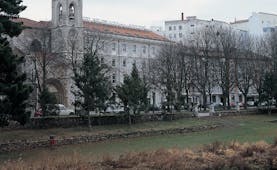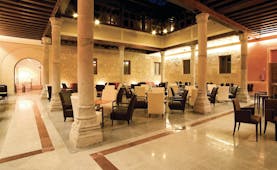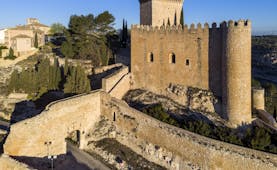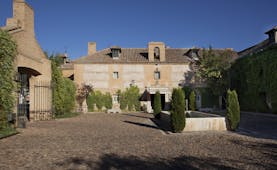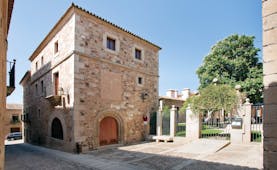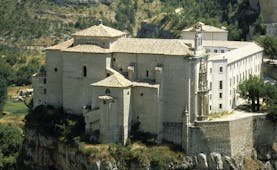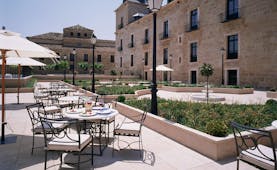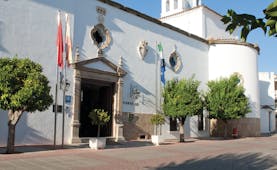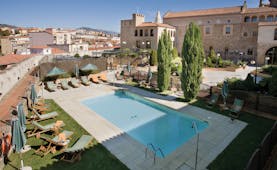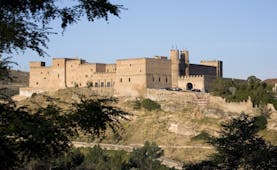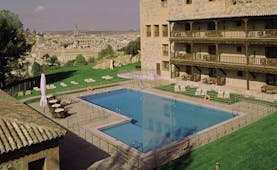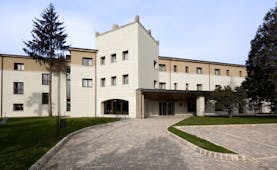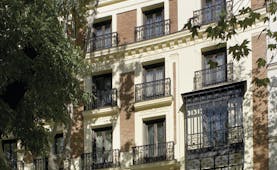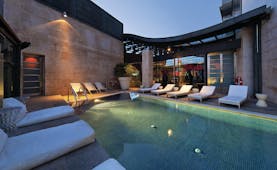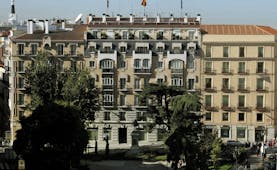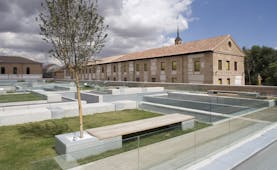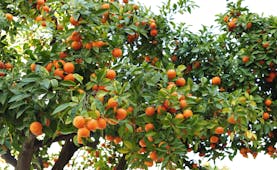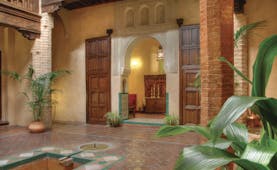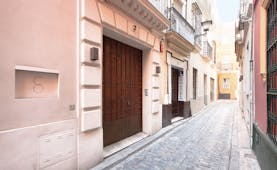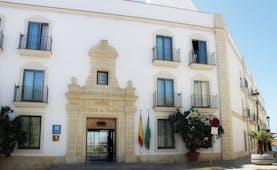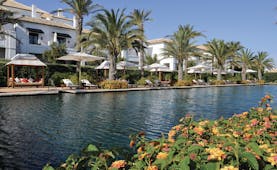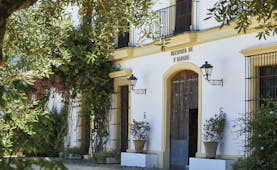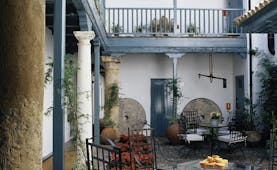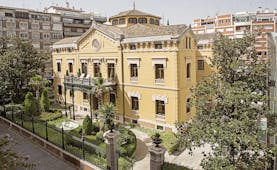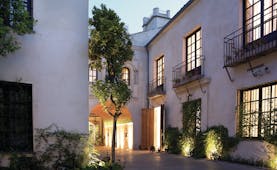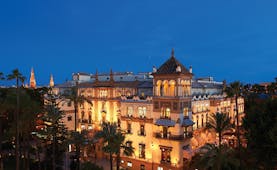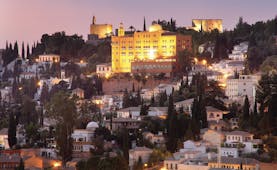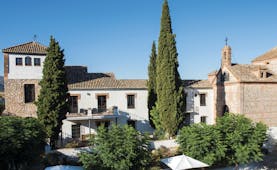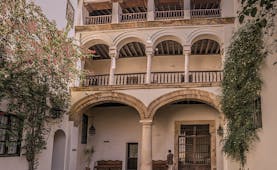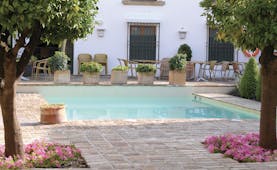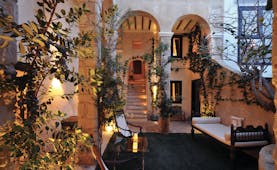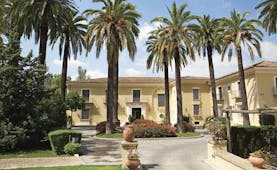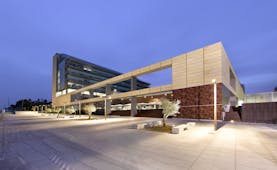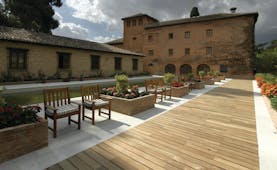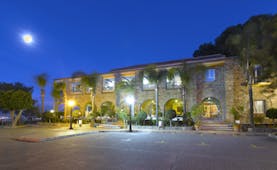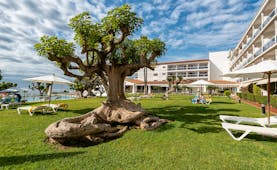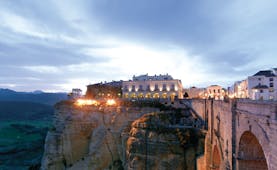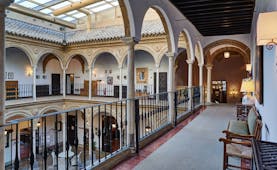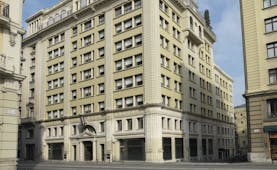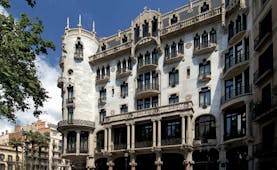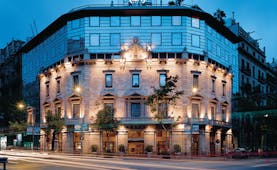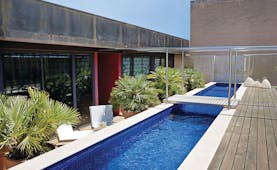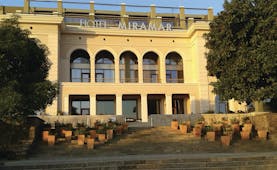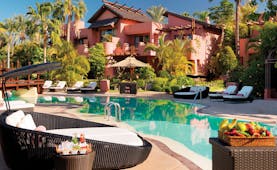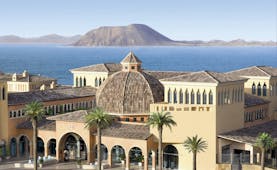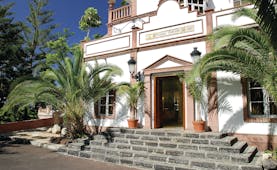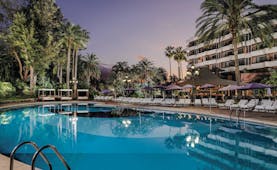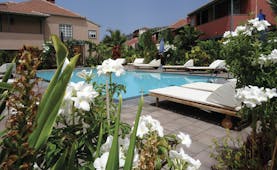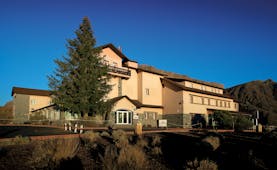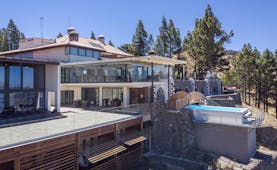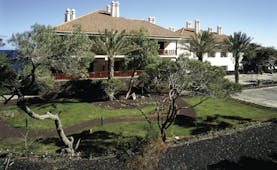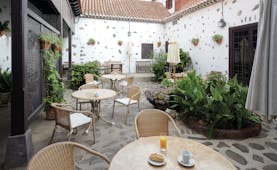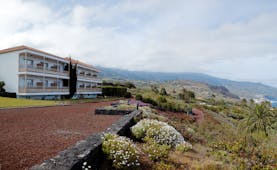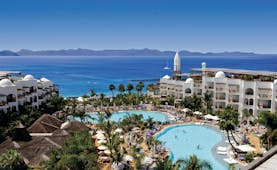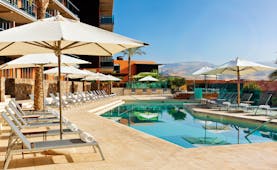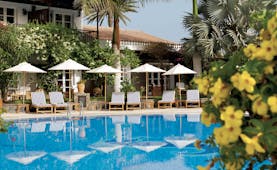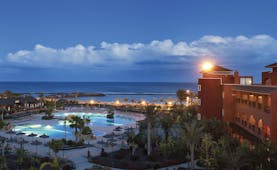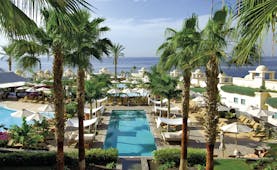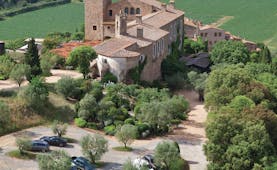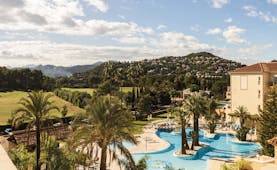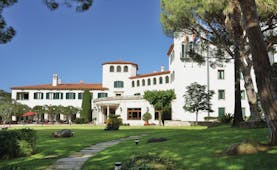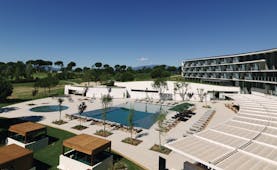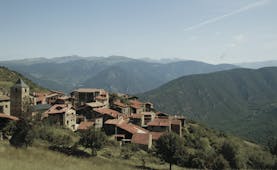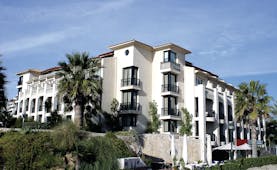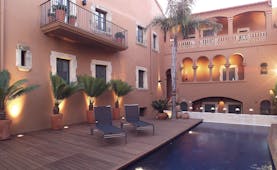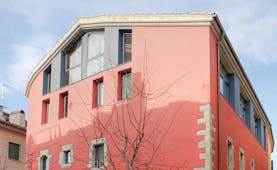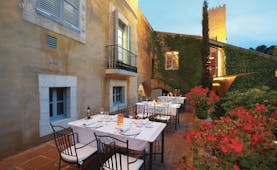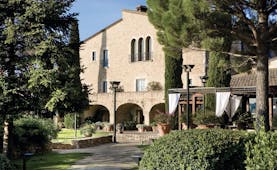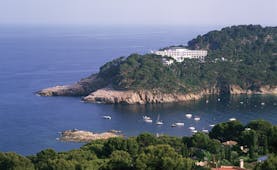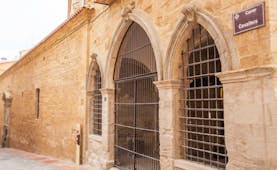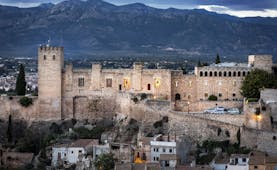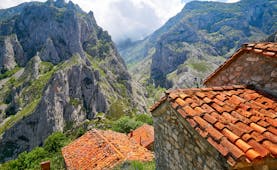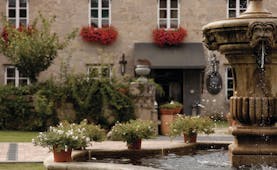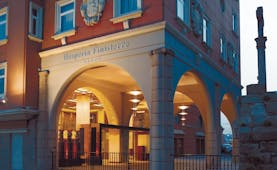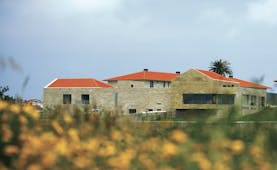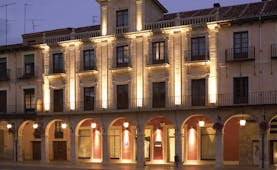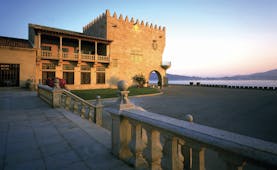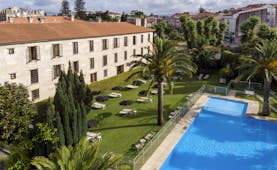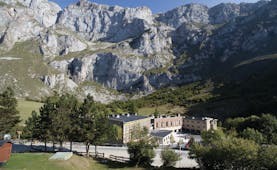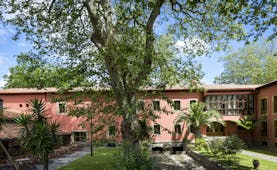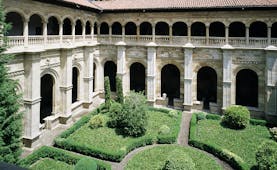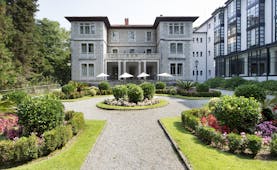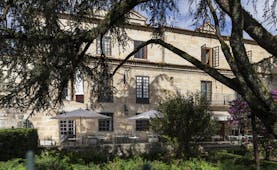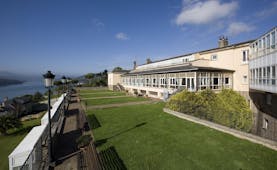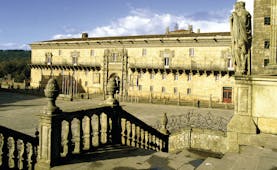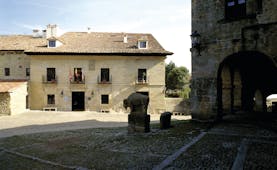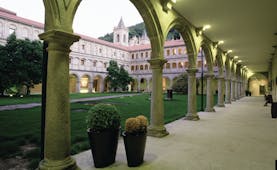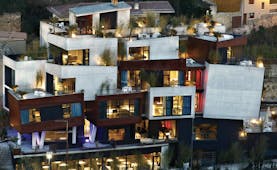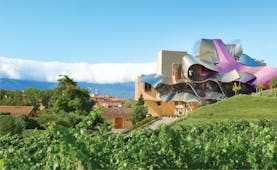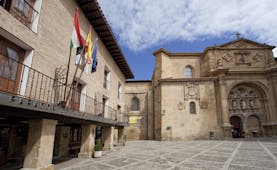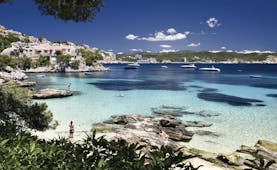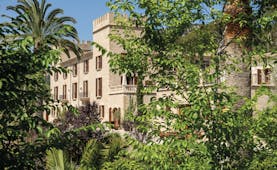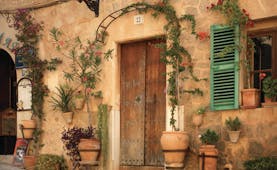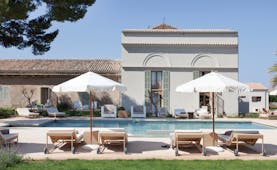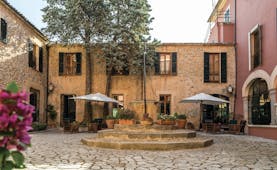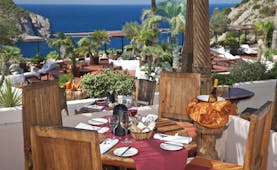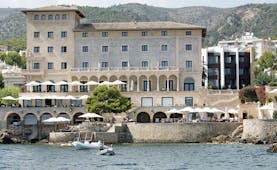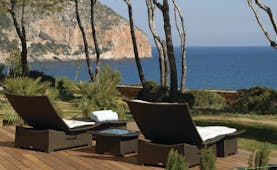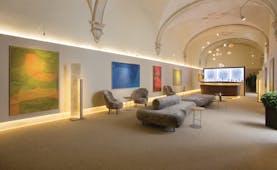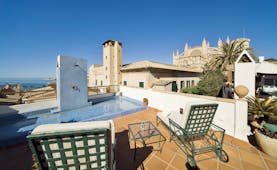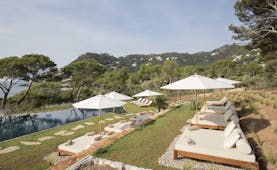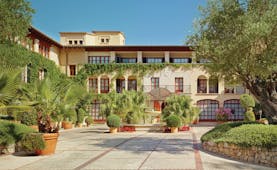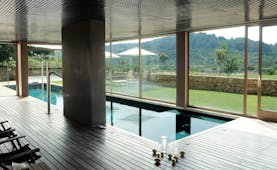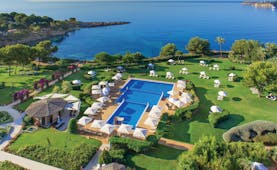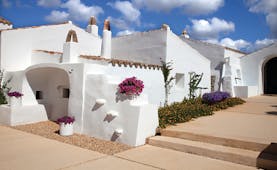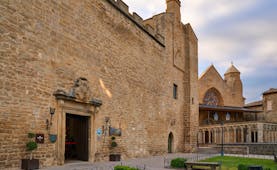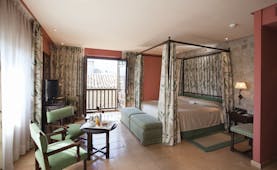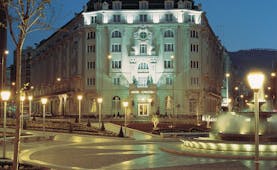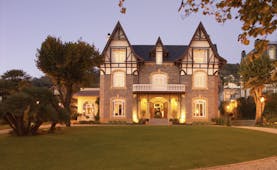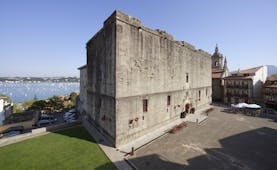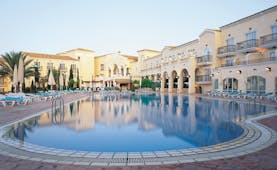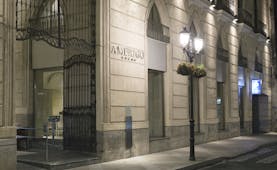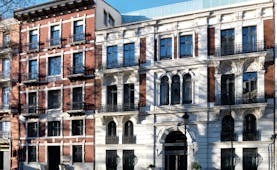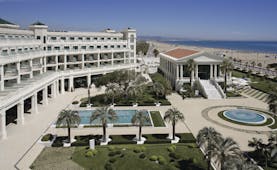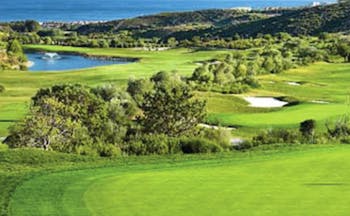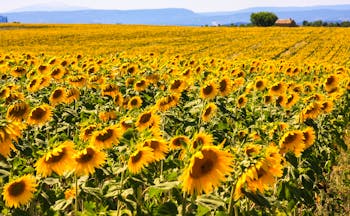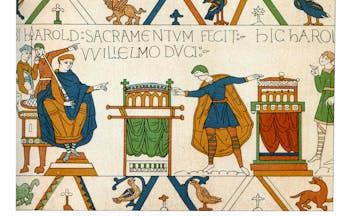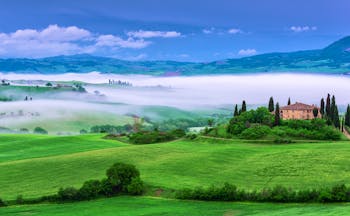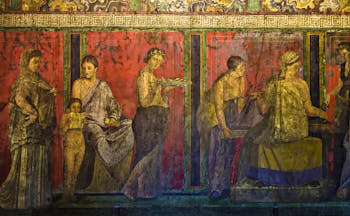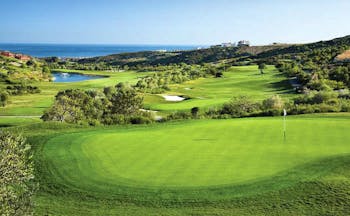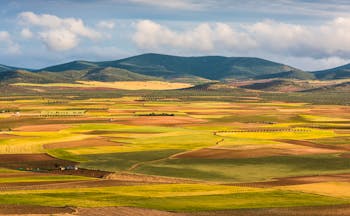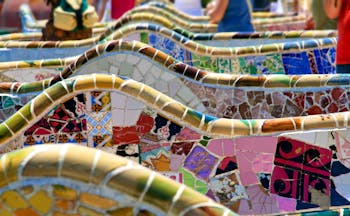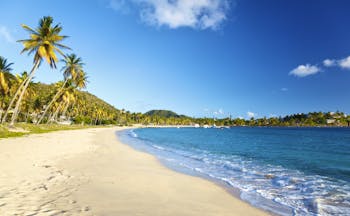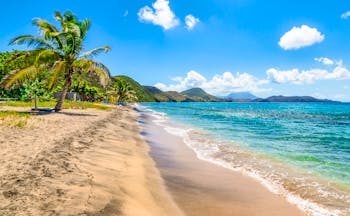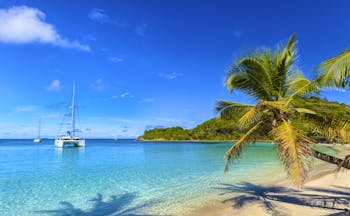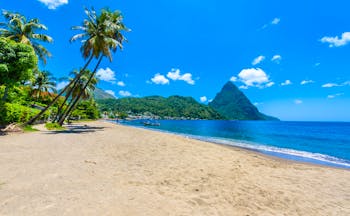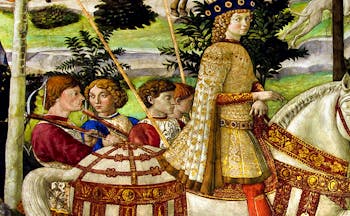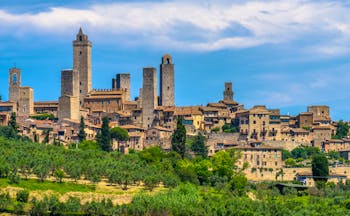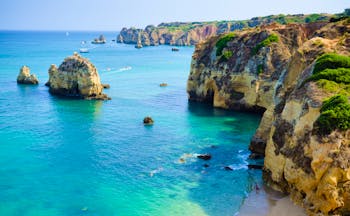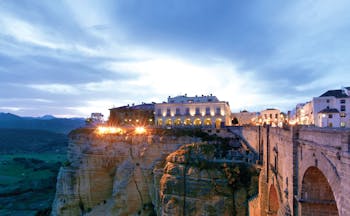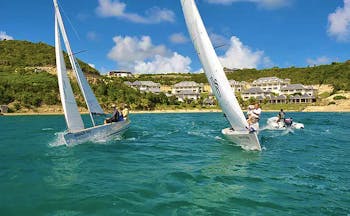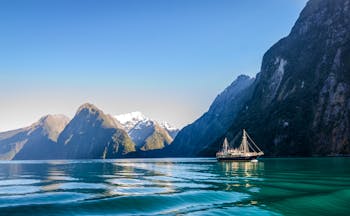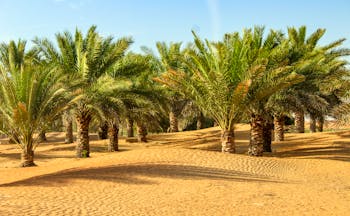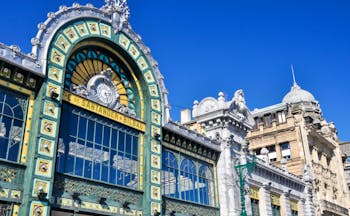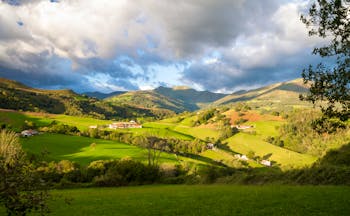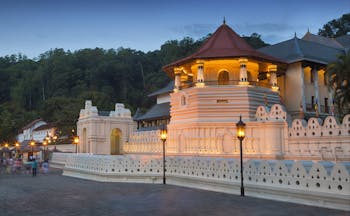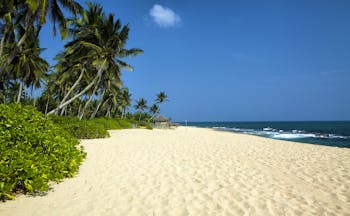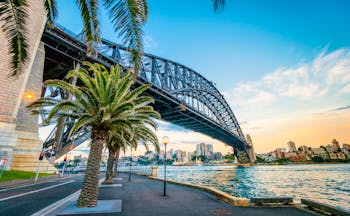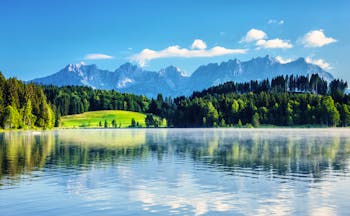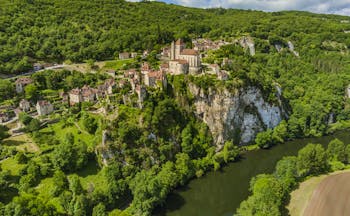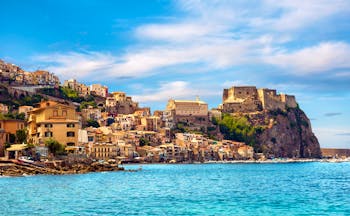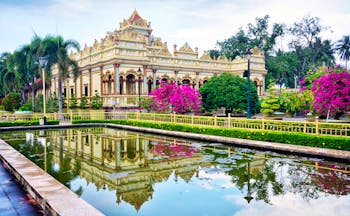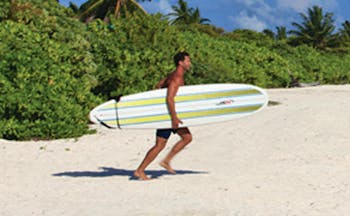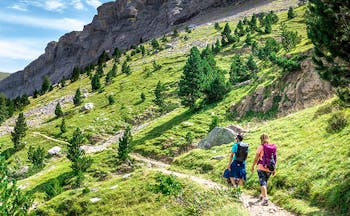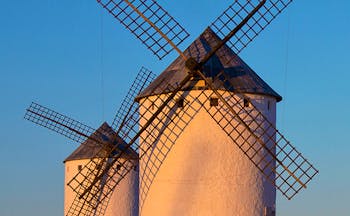Luxury fly-drive touring holiday Castles, Palaces and Windmills of Castille with Madrid and La Mancha
This 7-night luxury fly-drive tour of the Castles, Palaces and Windmills of Castile captures the historical charm and magic of Castile, at the heart of Spain. Moorish, Christian, Romantic and fairytale architecture tell the history of Spain as this fascinating tour illustrates. This touring holiday begins with two-night stay in Madrid with an opportunity to explore the many palaces and impressive buildings of Madrid, sampling the artistic treasures as you go. Next, drive on to Segovia and the Palacio San Facundo, and begin your investigation into the Castile Castles in earnest. Such imposing, but beautiful structures, as the royal El Escorial, the fairy-tale Alcázar, and the red-brick Coca Castle await. Your next stop is the Parador de Ávila, from where you will be in prime position to begin appreciating the famous Mudéjar architecture, as well as the outstandingly well-preserved mediaeval town walls. Take this opportunity to also visit Salamanca, the capital of the region. Your fourth stop on this touring holiday is the Parador de Toledo. This impressive city, hemmed in by the winding waters of the River Tajo, is home to a vast array of multicultural monuments. Trace the city’s history via the keyhole archways of its Arabic buildings, and the old Moorish town walls and Alcántara Bridge. Finally, move on to the Parador de Cuenca, just a short distance from the enchanting Ciudad Encantada, where the rock formations seem to resemble a living, breathing town. Nearby, Consuegra introduces you to the windmills of this tour: the very same mentioned in Miguel de Cervantes’ ‘Don Quixote'. Return to Madrid on your final day for your return flight to London. With this touring holiday, the driving times from place to place are quite short but this you chance to explore the countryside along the way or to arrive early sometimes, and to leave later in the day.
Highlights
Madrid • Visit the Prado • Visit El Escorial palace • Visit the Alcazar in Segovia • Segovia • Avila • Toledo • The Iglesia de Santiago del Arrabal • Windmills at Consuegra • Plaza de la Merced •Cuenca • Ciudad Encantada
Day by day
Begin your touring holiday by flying into Madrid, where you stay for two nights.
Three world-class art galleries adorn the streets of Madrid: the Prado, which exhibits pieces by the likes of Goya, Rubens, and Murillo, and specialises in art from between the 12th and 19th century; the Museo Thyssen-Bornemisza, which is one of the best private collections of 13th to 20th century works, housing the works of Goya, Degas, Renoir, and Kandinsky, and must be booked in advance; and the Museo Nacional Centro de Arte Reina Sofia which specialises in 20th and 21st century works, and houses Picasso’s ‘Guernica,’ along with an abstract film created by Salvador Dalí and Luis Buñuel. In Old Madrid, visit the Plaza Mayor, the arcaded square at the centre of the city, and the Palacio Real de Madrid, considered to be the official residence of the royal family. This palace is often open to visitors, allowing you to observe the expertly crafted Spanish marble, the stucco carvings, the frescoes painted by Giaquinto, Tiepolo, and Bayeu, and explore the Royal Armoury and the Royal Pharmacy. Outside the palace, the Plaza de Oriente is lined with statues of the Gothic Kings. You may want to visit the palace in the evening, though interior tours are only available in the day, to see the dramatic lighting that turns the intricately designed and dynamic palace to gold when the sun sets. Perhaps also visit the Real Basílica de San Francisco el Grande, known for possessing one of the most impressive domes in Spain. Its circular central chamber glows golden, with atmospheric lighting that seems to take you back in time, though the domed ceiling is painted with beautiful blue and green scenes. Less than three-quarters of an hour north of Madrid is the Castle of the Mendoza, otherwise known as the Castle of Manzanares El Real, believed to be one of the most beautiful castles in Spain. Appearing quite traditional in design, with an essentially square shape and circular towers at each corner, this castle is one of the last remaining, but best examples, of Castilian military architecture, and dates from the 15th century. Built over six storeys, and with a central courtyard, there is a lot to explore. The Gothic Gallery on the first floor is considered to be one of the most remarkable and rewarding in Spain. The Hotel Villa Real Madrid is a wonderfully elegant property, housed within a 19th century property, but with a unique blend of old-world and present-day style. On your two evenings in Madrid, either locate one of the many Michelin-starred restaurants in the city, or dine at the gastronomic East 47 Restaurant, named after Andy Warhol's New York studio, back at your hotel. Either dine inside surrounded by pop art prints and contemporary Spanish art, or on the terrace overlooking the square.
In the morning of your third day, collect your hire-car and drive northwards towards Segovia, visiting the imposing El Escorial en-route. This vast castle complex is a stunning site among the foothills of the Sierra de Guadarrama, and consists of a Royal Pantheon, a monastery, a royal palace and a library. The interior, just as much as the formidable alabaster exterior, is defined by the attention to detail in its design and decoration. Each room is unendingly aesthetically pleasing, with arched ceilings adorned with frescoes, and walls covered by dark wood bookcases. You stay in Segovia for two nights.
Segovia is a beautiful city whose old quarter is a World Heritage Site, as is the spectacular Roman Aqueduct which dates back 2000 years. Another much-photographed sight in Segovia is the hill-top Alcázar, a fairy-tale fortress with pointed turrets and towers which served as inspiration for Walt Disney’s Cinderella Castle. Approach the Alcázar via the zigzagging pathway that leads up the rocky hillside to the building’s perch. Its unusual shape makes it perfectly suited to its environment, and also adds an element of intrigue to any visit. Navigate the labyrinth and wander the hallways to see the informative and historic exhibits. Less than an hour northwest of Segovia is the Coca Castle. This brick-built castle was once part of an important defensive square, along with the castles of Cuellar, Arevalo, and Olmedo. The outer and inner enclosures are shaped by both polygonal and semi-circular turrets on every wall and tower, giving the castle a unique aspect. Around its base, runs a 40ft deep moat. Hours can be leisurely and pleasurably passed climbing the narrow staircases that lead up to the ramparts or down to the moat, and then following the panoramic views around the circumference. Slightly further on is the Castillo de la Mota, which originally dates from mediaeval times, but has been reconstructed more recently. This castle bears a similar imposing façade to the others mentioned on this tour, with wide towers and a shady inner courtyard. Its history is gloomy, serving as an arsenal, the Royal Archive, a school, and a prison at various points in history. Back in Segovia, visit the Cathedral. Built at the highest point in the town, this Gothic cathedral was the last one of its kind built in Spain, and dates from the 16th century. Its watchtower is possibly its most striking feature, as it is the most immediately visible from all over Segovia. Enter the main building through one of its three main entrances, and navigate through the 23 chapels, appreciating the magnificent examples of Spanish religious art as you go. The unusual shape of the semi-circular presbytery and ambulatory aids the acoustics of the interior and has a very pleasing effect on the tiered exterior.
Perhaps, on your journey to Ávila, use this opportunity to make a detour to Coca Castle to see that outstanding example of Mudéjar architecture if you have not already. When you reach Ávila, check in to the historic Parador de Ávila, which is set amid the cobbled streets of the town centre. Spend the rest of the day in Ávila, where well-preserved mediaeval walls enclose the centre of the World Heritage City. Visitors can stroll along the ramparts and enter the cathedral, which is integrated into the distinctive colourful stonework of the town walls. On your travels around the town, you may wish to stop off at the Church of San Juan Battista, the beautifully refined Monasterio de Nuestra Señora de Gracia, and the Cuatro Postes on the town’s edge, all of which are tied into Ávila’s history with St Teresa of Jesus. You will also notice the lasting influence of the Mudéjar masters, as well as the abundance of granite in the architecture of the town, which gives the Cathedral a very austere look. The Basílica of San Vicente is an example of the unique Spanish Romanesque style, with wonderfully measured grey pillars and tan brick walls. Just over an hour’s drive west will bring you to Salamanca, the capital of the Castile region, and known for its impressive sandstone architecture. Tour the surprisingly peaceful streets, from the Cathedral of two parts (the New Cathedral with its individualistic carvings and the Romanesque Old Cathedral), to the Plaza Mayor, and the Convent. Dine on refined local cuisine at the Parador de Ávila in the evening, and then relax in the warmth of the cosy rooms, which look out over the red rooftops of the town. You spend one night in Ávila.
Today from Ávila you drive approximately two hours southwards to Toledo. Toledo is a fascinating, historic destination known as the City of Three Cultures due to the co-existence of Christianity, Islam, and Judaism which has been essential to its prosperity. Its picturesque appearance comes from its rising spire and its situation, built as it is into a wide meander of the River Tajo. The former capital of Spain, it is home to a spectacular Gothic cathedral alongside synagogues and mosques, and was the home of El Greco, a Greek painter who lived in the city in the 16th Century. The Gothic cathedral is tightly nestled in between Toledo’s narrow streets, and at ground level seems to emerge quite suddenly. It was originally built in the 13th century on the site of a Muslim mosque. Now, it houses a breath-taking interior and a rich collection of paintings by the likes of Rubens, Raphael, and Titian in its sanctuary. Visitors must enter through the Puerta de Mollete, named after the Spanish word for ‘Muffin’ because it was here that food was traditionally distributed to the poor. The 88 interior columns ensure that your first impressions of this building are striking, and the beautiful stained-glass windows, some of which date back to the 13th century, add a splash of ethereal colour. If you have more time in the cathedral, perhaps visit the marble tombs in the Capilla de Santiago, or the ‘retablo’ of New Testament scenes in the Capilla Mayor. For a taste of multicultural Toledo, spend time in the Cristo de la Luz, wandering through the keyhole archways and admiring the colourful stone, or in the Santa María la Blanca. The Iglesia de Santiago del Arrabal is one of the most stunning examples of Mudéjar architecture in the city, with dark brick and curved, indented walls; while the Puerta Vieja de Bisagra is the only remaining section of the Moorish town walls. There are too many excellent historic sights in Toledo to see in one day, so you may wish to extend your stay in order to visit the 13th century Moorish Puente de Alcántara, the Iglesia de Santo Tomé, which resembles the Minarets of Morocco, and the simple yet charming Castillo de San Servando. Before leaving Toledo, browse the damascene metalwork in one of the small shops, and pick up some of the delicious local marzipan. You stay in Toledo for one night.
From Toledo it is approximately 45 minutes’ drive south to Consuegra, where you will find the iconic windmills described in Miguel de Cervantes’ stories about the fictional ’Don Quixote’. Of the white windmills which are found throughout Castile la Mancha, those that stand along the Cerro Calderico ridge are some of the best preserved. Then, drive for about two hours eastwards through the rolling countryside of La Mancha to Cuenca, where you stay at the Parador de Cuenca for one night. This luxury hotel occupies a former Dominican convent and offers its guests stunning views over the ravine. The historic centre of this World Heritage City is set on a ridge between the Júcar and Huécar river canyons, where the wooden balconies of the famous Casas Colgadas (hanging houses) appear to hang over steep cliffs. On this street, in one of the intriguing houses, you will find the Museum of Spanish Abstract Art, which is one of the best in Spain. The old part of the city’s position on the promontory gives it views over the ruins of the ancient Moorish Kunka fortress, while the more modern district has begun to sprawl on the distant plain. The Cuenca Baroque style can be seen in the church and convent around the Plaza de la Merced, while the rest of the city is an eclectic mingling of architectural styles. Other points of interest within the city include the Gothic cathedral, which was built on the site of a former mosque, a number of interesting museums and the charming Plaza Mayor, on to which the arches of the Town Hall, and several cosy inns, open. The restaurant at the Parador de Cuenca is the perfect place to sample some of the region’s best cuisine on your last night in Spain. To finish off your experience of Cuenca, take an evening stroll from the bottom of the old town to the highest point in the city, passing the Church of San Miguel, the Church of San Nicolás, the Church of San Pedro, and the hermitage of the Nuestra Señora de la Angustias on your way. You spend one night in Cuenca.
Depending on the time of your flight, it’s worth trying to incorporate a final interesting excursion to the Ciudad Encantada, or Enchanted City, just half an hour’s drive from Cuenca. This phenomenal beauty spot hidden in the depths of a canyon has been carved by water for centuries; the limestone has been eroded by ice, wind and water, leaving spectacular rock formations that resemble objects, houses, animals, and people behind. From here, allow about three hours for the drive north west to Madrid Airport, where you return your hire-car and catch your flight back to London.
It has been a lovely holiday & once again, you did not disappoint. Thank you again for everything. We look forward to contacting you again for our next adventure.Mrs H, July 2025
Holiday price guide Prices from £1,920 per person based on two people sharing a double or twin room.
Holiday Code SNFD02
Call us on 01392 441245
Luxury fly-drive touring holiday Castles, Palaces and Windmills of Castille with Madrid and La Mancha
Begin your touring holiday by flying into Madrid, where you stay for two nights.
Three world-class art galleries adorn the streets of Madrid: the Prado, which exhibits pieces by the likes of Goya, Rubens, and Murillo, and specialises in art from between the 12th and 19th century; the Museo Thyssen-Bornemisza, which is one of the best private collections of 13th to 20th century works, housing the works of Goya, Degas, Renoir, and Kandinsky, and must be booked in advance; and the Museo Nacional Centro de Arte Reina Sofia which specialises in 20th and 21st century works, and houses Picasso’s ‘Guernica,’ along with an abstract film created by Salvador Dalí and Luis Buñuel. In Old Madrid, visit the Plaza Mayor, the arcaded square at the centre of the city, and the Palacio Real de Madrid, considered to be the official residence of the royal family. This palace is often open to visitors, allowing you to observe the expertly crafted Spanish marble, the stucco carvings, the frescoes painted by Giaquinto, Tiepolo, and Bayeu, and explore the Royal Armoury and the Royal Pharmacy. Outside the palace, the Plaza de Oriente is lined with statues of the Gothic Kings. You may want to visit the palace in the evening, though interior tours are only available in the day, to see the dramatic lighting that turns the intricately designed and dynamic palace to gold when the sun sets. Perhaps also visit the Real Basílica de San Francisco el Grande, known for possessing one of the most impressive domes in Spain. Its circular central chamber glows golden, with atmospheric lighting that seems to take you back in time, though the domed ceiling is painted with beautiful blue and green scenes. Less than three-quarters of an hour north of Madrid is the Castle of the Mendoza, otherwise known as the Castle of Manzanares El Real, believed to be one of the most beautiful castles in Spain. Appearing quite traditional in design, with an essentially square shape and circular towers at each corner, this castle is one of the last remaining, but best examples, of Castilian military architecture, and dates from the 15th century. Built over six storeys, and with a central courtyard, there is a lot to explore. The Gothic Gallery on the first floor is considered to be one of the most remarkable and rewarding in Spain. The Hotel Villa Real Madrid is a wonderfully elegant property, housed within a 19th century property, but with a unique blend of old-world and present-day style. On your two evenings in Madrid, either locate one of the many Michelin-starred restaurants in the city, or dine at the gastronomic East 47 Restaurant, named after Andy Warhol's New York studio, back at your hotel. Either dine inside surrounded by pop art prints and contemporary Spanish art, or on the terrace overlooking the square.
In the morning of your third day, collect your hire-car and drive northwards towards Segovia, visiting the imposing El Escorial en-route. This vast castle complex is a stunning site among the foothills of the Sierra de Guadarrama, and consists of a Royal Pantheon, a monastery, a royal palace and a library. The interior, just as much as the formidable alabaster exterior, is defined by the attention to detail in its design and decoration. Each room is unendingly aesthetically pleasing, with arched ceilings adorned with frescoes, and walls covered by dark wood bookcases. You stay in Segovia for two nights.
Segovia is a beautiful city whose old quarter is a World Heritage Site, as is the spectacular Roman Aqueduct which dates back 2000 years. Another much-photographed sight in Segovia is the hill-top Alcázar, a fairy-tale fortress with pointed turrets and towers which served as inspiration for Walt Disney’s Cinderella Castle. Approach the Alcázar via the zigzagging pathway that leads up the rocky hillside to the building’s perch. Its unusual shape makes it perfectly suited to its environment, and also adds an element of intrigue to any visit. Navigate the labyrinth and wander the hallways to see the informative and historic exhibits. Less than an hour northwest of Segovia is the Coca Castle. This brick-built castle was once part of an important defensive square, along with the castles of Cuellar, Arevalo, and Olmedo. The outer and inner enclosures are shaped by both polygonal and semi-circular turrets on every wall and tower, giving the castle a unique aspect. Around its base, runs a 40ft deep moat. Hours can be leisurely and pleasurably passed climbing the narrow staircases that lead up to the ramparts or down to the moat, and then following the panoramic views around the circumference. Slightly further on is the Castillo de la Mota, which originally dates from mediaeval times, but has been reconstructed more recently. This castle bears a similar imposing façade to the others mentioned on this tour, with wide towers and a shady inner courtyard. Its history is gloomy, serving as an arsenal, the Royal Archive, a school, and a prison at various points in history. Back in Segovia, visit the Cathedral. Built at the highest point in the town, this Gothic cathedral was the last one of its kind built in Spain, and dates from the 16th century. Its watchtower is possibly its most striking feature, as it is the most immediately visible from all over Segovia. Enter the main building through one of its three main entrances, and navigate through the 23 chapels, appreciating the magnificent examples of Spanish religious art as you go. The unusual shape of the semi-circular presbytery and ambulatory aids the acoustics of the interior and has a very pleasing effect on the tiered exterior.
Perhaps, on your journey to Ávila, use this opportunity to make a detour to Coca Castle to see that outstanding example of Mudéjar architecture if you have not already. When you reach Ávila, check in to the historic Parador de Ávila, which is set amid the cobbled streets of the town centre. Spend the rest of the day in Ávila, where well-preserved mediaeval walls enclose the centre of the World Heritage City. Visitors can stroll along the ramparts and enter the cathedral, which is integrated into the distinctive colourful stonework of the town walls. On your travels around the town, you may wish to stop off at the Church of San Juan Battista, the beautifully refined Monasterio de Nuestra Señora de Gracia, and the Cuatro Postes on the town’s edge, all of which are tied into Ávila’s history with St Teresa of Jesus. You will also notice the lasting influence of the Mudéjar masters, as well as the abundance of granite in the architecture of the town, which gives the Cathedral a very austere look. The Basílica of San Vicente is an example of the unique Spanish Romanesque style, with wonderfully measured grey pillars and tan brick walls. Just over an hour’s drive west will bring you to Salamanca, the capital of the Castile region, and known for its impressive sandstone architecture. Tour the surprisingly peaceful streets, from the Cathedral of two parts (the New Cathedral with its individualistic carvings and the Romanesque Old Cathedral), to the Plaza Mayor, and the Convent. Dine on refined local cuisine at the Parador de Ávila in the evening, and then relax in the warmth of the cosy rooms, which look out over the red rooftops of the town. You spend one night in Ávila.
Today from Ávila you drive approximately two hours southwards to Toledo. Toledo is a fascinating, historic destination known as the City of Three Cultures due to the co-existence of Christianity, Islam, and Judaism which has been essential to its prosperity. Its picturesque appearance comes from its rising spire and its situation, built as it is into a wide meander of the River Tajo. The former capital of Spain, it is home to a spectacular Gothic cathedral alongside synagogues and mosques, and was the home of El Greco, a Greek painter who lived in the city in the 16th Century. The Gothic cathedral is tightly nestled in between Toledo’s narrow streets, and at ground level seems to emerge quite suddenly. It was originally built in the 13th century on the site of a Muslim mosque. Now, it houses a breath-taking interior and a rich collection of paintings by the likes of Rubens, Raphael, and Titian in its sanctuary. Visitors must enter through the Puerta de Mollete, named after the Spanish word for ‘Muffin’ because it was here that food was traditionally distributed to the poor. The 88 interior columns ensure that your first impressions of this building are striking, and the beautiful stained-glass windows, some of which date back to the 13th century, add a splash of ethereal colour. If you have more time in the cathedral, perhaps visit the marble tombs in the Capilla de Santiago, or the ‘retablo’ of New Testament scenes in the Capilla Mayor. For a taste of multicultural Toledo, spend time in the Cristo de la Luz, wandering through the keyhole archways and admiring the colourful stone, or in the Santa María la Blanca. The Iglesia de Santiago del Arrabal is one of the most stunning examples of Mudéjar architecture in the city, with dark brick and curved, indented walls; while the Puerta Vieja de Bisagra is the only remaining section of the Moorish town walls. There are too many excellent historic sights in Toledo to see in one day, so you may wish to extend your stay in order to visit the 13th century Moorish Puente de Alcántara, the Iglesia de Santo Tomé, which resembles the Minarets of Morocco, and the simple yet charming Castillo de San Servando. Before leaving Toledo, browse the damascene metalwork in one of the small shops, and pick up some of the delicious local marzipan. You stay in Toledo for one night.
From Toledo it is approximately 45 minutes’ drive south to Consuegra, where you will find the iconic windmills described in Miguel de Cervantes’ stories about the fictional ’Don Quixote’. Of the white windmills which are found throughout Castile la Mancha, those that stand along the Cerro Calderico ridge are some of the best preserved. Then, drive for about two hours eastwards through the rolling countryside of La Mancha to Cuenca, where you stay at the Parador de Cuenca for one night. This luxury hotel occupies a former Dominican convent and offers its guests stunning views over the ravine. The historic centre of this World Heritage City is set on a ridge between the Júcar and Huécar river canyons, where the wooden balconies of the famous Casas Colgadas (hanging houses) appear to hang over steep cliffs. On this street, in one of the intriguing houses, you will find the Museum of Spanish Abstract Art, which is one of the best in Spain. The old part of the city’s position on the promontory gives it views over the ruins of the ancient Moorish Kunka fortress, while the more modern district has begun to sprawl on the distant plain. The Cuenca Baroque style can be seen in the church and convent around the Plaza de la Merced, while the rest of the city is an eclectic mingling of architectural styles. Other points of interest within the city include the Gothic cathedral, which was built on the site of a former mosque, a number of interesting museums and the charming Plaza Mayor, on to which the arches of the Town Hall, and several cosy inns, open. The restaurant at the Parador de Cuenca is the perfect place to sample some of the region’s best cuisine on your last night in Spain. To finish off your experience of Cuenca, take an evening stroll from the bottom of the old town to the highest point in the city, passing the Church of San Miguel, the Church of San Nicolás, the Church of San Pedro, and the hermitage of the Nuestra Señora de la Angustias on your way. You spend one night in Cuenca.
Depending on the time of your flight, it’s worth trying to incorporate a final interesting excursion to the Ciudad Encantada, or Enchanted City, just half an hour’s drive from Cuenca. This phenomenal beauty spot hidden in the depths of a canyon has been carved by water for centuries; the limestone has been eroded by ice, wind and water, leaving spectacular rock formations that resemble objects, houses, animals, and people behind. From here, allow about three hours for the drive north west to Madrid Airport, where you return your hire-car and catch your flight back to London.
It has been a lovely holiday & once again, you did not disappoint. Thank you again for everything. We look forward to contacting you again for our next adventure.Mrs H, July 2025
Holiday price guide Prices from £1,920 per person based on two people sharing a double or twin room.
Holiday Code SNFD02
Our prices include
● Scheduled flights with British Airways, from London to Madrid return
● Hire of a Group C car for 6 days
● 2 nights’ bed and breakfast in a Double Room at the Hotel Urban Madrid
● 2 nights’ bed and breakfast in a Double Room at the Palacio San Facundo in Segovia
● 1 night’s bed and breakfast in a Double Room at the Parador de Ávila
● 1 night’s bed and breakfast in a Double Room at the Parador de Toledo
● 1 night’s bed and breakfast in a Double Room at the Parador de Cuenca
● Concierge service and Expressions Holidays regional helpful hints
Our prices do not include
● Early check-in or late check-out at any hotels (although we can arrange this on request at additional cost)
● Any other services not mentioned above, such as transfers and meals except breakfast at hotels
● Personal holiday insurance. This is essential and cover should be in place from when you book the holiday.
● Local tourist tax, usually between Euros 1 and 3 per person per night, and payable locally to the hotel
● Transfers in Madrid
Additional information
Driving times for this touring holiday
Madrid to Segovia 2 hours 5 minutes
Segovia to Ávila 55 minutes
Ávila to Toledo 1 hour 45 minutes
Toledo to Cuenca 1 hour 50 minutes
Cuenca to Madrid 1 hour 45 minutes (2 hours 30 minutes via Consuegra)
Call us on 01392 441245
Luxury fly-drive touring holiday Castles, Palaces and Windmills of Castille with Madrid and La Mancha

Hotel Urban is a 5-star boutique art hotel in an excellent central location. A Michelin-starred restaurant and wonderful rooftop terrace with swimming pool provides the perfect space to relax after a day spent exploring Madrid.
Double room
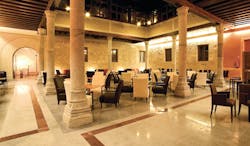
Palacio San Facundo is a 4-star boutique hotel that combines traditional features and contemporary style in an excellent central location. Comfortable, elegant accommodation makes it an excellent base from which to explore Segovia and the surrounding area.
Double room
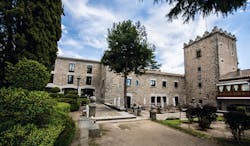
Parador de Ávila is a 4-star hotel in an excellent location inside the walled mediaeval city. The grand interiors and meticulous service make this hotel a great place from which to explore the wonders of the historical city.
Double room

Parador de Toledo is a 4-star historical hotel in a beautiful location overlooking Toledo. The comfort and luxury of this hotel and its delicious local cuisine is ideal after a day's exploration of the historic city.
Double room

Parador de Cuenca is a 4-star hotel in renovated monastery, the history of which can be read from its mix of different architectural styles. The hotel boasts magnificent views of the Hanging Houses and Huécar Gorge.
Double room
It has been a lovely holiday & once again, you did not disappoint. Thank you again for everything. We look forward to contacting you again for our next adventure.Mrs H, July 2025
Holiday price guide Prices from £1,920 per person based on two people sharing a double or twin room.
Holiday Code SNFD02
Call us on 01392 441245
Luxury fly-drive touring holiday Castles, Palaces and Windmills of Castille with Madrid and La Mancha
About Heart of Spain
An Expressions tailor-made holiday to the Heart of Spain feature some of the best four and five star hotels in central Spain, featuring vineyard hotels, rural estates and city properties. Located at the geographical heart of Spain is its vibrant capital, Madrid, where days can be filled with art galleries and atmospheric outdoor cafes, and evenings promise an energetic nightlife. Surrounding the city are the dry plains of the country's central plateau which are divided by spectacular mountain ranges and dotted with numerous castles, magnificent cathedrals and ancient Roman ruins. The regions which make up Spain's central plateau have all played a hugely important role in the history of modern Spain, which is evident in the numerous castles which were built to protect towns and villages as the Moors fought the Christians in the 10th and 11th centuries. These are some of the least visited parts of Spain where few tourists venture outside of the main cities, ensuring that visitors will leave feeling like they have discovered something new. At the centre of Spain is Madrid, where atmospheric cobbled streets link bustling squares which are filled with pavement cafes and flea markets, whilst tree-line boulevards are overlooked by neo-classical buildings. Surrounding the city are the dry plains of the country's central plateau which are divided by spectacular mountain ranges and dotted with numerous castles, magnificent cathedrals and ancient Roman ruins. To the north of Madrid is Castilla y León, an elevated region which has played a hugely important role in the history of modern Spain. Rolling countryside is littered with historic cities, isolated villages and mediaeval castles, built by the Christians to defend against the Moorish invaders. Salamanca, Avila, Segovia, León, Valladolid and Burgos are all home to a wealth of art and stunning architecture, including Gothic cathedrals and Roman structures. Away from the cities are natural attractions including mountain ranges and nature reserves, with wheat fields and vineyards covering the high plateaus. To the south and east of Madrid is Castilla-La Mancha, an expansive region with dry plains stretching towards mountains in the distance. The predominantly flat scenery is made up of olive groves, wheat fields, extensive vineyards, hilltop castles and the iconic windmills described by Cervantes. Head to the historic city of Toledo, where Christian, Jewish and Arab cultures blend to create a popular tourist destination, or to Cuenca, a dramatic town where houses seemingly dangle over a plunging gorge. Further west towards the border with Portugal is Extremadura, a region with green pastures and rolling hills, forests and fertile river valleys, as well as charming towns boasting stunning examples of Roman architecture. Elaborate palaces and manor houses are found in clusters throughout the region, built by conquistadors with gold from the New World.
Highlights of the Heart of Spain
The three world-class art galleries which make up Madrid's Golden Triangle of Art, home to works by Pablo Picasso, Salvador Dalí and Francisco de Goya. The historical sights of Old Madrid, including the lavish Royal Palace, the grand Plaza Mayor and the city's spiritual centre, Puerta del Sol. Parque del Retiro, a popular spot for relaxation in the centre of Madrid with a boating lake. El Escorial, a large royal residence just outside Madrid which also functions as a monastery and is where many Spanish monarchs are buried. The Gothic cathedrals of León, Burgos and Toledo which feature stunning stained glass, mediaeval art and elaborate sculptures. The numerous castles which are scattered across the region including the Gothic-style Belmonte Castle, the Mudejár Coca Castle and the Moorish Alcazaba of Badajoz. The university city of Alcalá de Henares, birthplace of Cervantes, the 16th century author who wrote about the adventures of Don Quixote. The walled city of Ávila. The university city of Salamanca. Segovia, with its Roman Aqueduct and distinctive castle. Cuenca, a picturesque old town with houses which appear to hang over a gorge. The iconic windmills which sit on the plains near Consuegra. Roman ruins in Mérida. Elaborate palaces and manor houses in Trujillo and Cáceres. The wine-producing regions throughout central Spain including Ribera del Duero, La Mancha and Valdepeñas where visitors can visit vineyards and enjoy wine tastings. Mountain ranges which divide the central plateau, with many opportunities for walking and rock climbing.
Festivals in the Heart of Spain
February: Caja Madrid Flamenco Festival, February to March: Madrid Carnival, February to March: Madrid Contemporary Art Fair, March/April: Holy week celebrations, May: San Isidro bullfighting festival (Madrid), May/June: Toledo Corpus Christi processions (Toledo), July to August: Madrid summer arts festival, October: Saffron Rose Festival (Consuegra), October: Cervantes Week (Alcala de Henares), October to November: Madrid Autumn Festival
Gastronomy in the Heart of Spain
As expected, Madrid is home to some excellent restaurants serving a great range of cuisine from throughout Spain and around the world. Roasted meat and game as well as a variety of broths and stews are common features on menus throughout central Spain, where traditional cooking is simple and hearty. Cuisine varies slightly between the regions, with more paprika and saffron being used in the south. Various pulses are grown on the plains of Castilla y León, whilst Manchego cheese produced in La Mancha and high quality Ibérico ham is produced in Extremadura. There are a number of wine regions which produce high-quality red and white wines. Local dishes include ‘Pollo a lo Padre Pero’ (chicken with a spicy sauce), ‘El frite’ (fried lamb), ‘Sopa de ajo’ (garlic soup), ‘Pisto manchego’ (similar to ratatouille), ‘Yemas’ (a rich dessert made with egg yolks).
Climate in the Heart of Spain
The climate of central Spain is generally quite extreme, with extremely hot summers and bitterly cold yet dry winters. Rainfall is generally quite low thanks to the mountains which surround the region. Madrid can be almost unbearable in the summer months as temperatures reach 40 degrees, whilst during the temperatures regularly drop below freezing. Spring and autumn are the best times to visit as temperatures are warm and pleasant, although there is increased rainfall.
Call us on 01392 441245
Luxury fly-drive touring holiday Castles, Palaces and Windmills of Castille with Madrid and La Mancha
About Madrid
An Expressions tailor-made holiday to Madrid is a chance to explore this lively and passionate capital city with a laid-back lifestyle. Atmospheric cobbled streets link bustling squares which are filled with pavement cafes, whilst tree-lined boulevards are overlooked by neo-classical buildings. Our luxury holidays to Madrid feature some of the best four- and five-star hotels in the city, including elegant hotels and more boutique properties. Visitors to Madrid will find plenty to fill their days. Art and culture play an important role, primarily thanks to the three world-class art museums which make up Madrid’s Golden Triangle of Art, home to works by Pablo Picasso, Salvador Dalí and Francisco de Goya. Illustrating the city’s rich history are the sights of Old Madrid, including the lavish Royal Palace, the grand Plaza Mayor, and the city’s spiritual centre – Puerta del Sol. There are plenty of designer shops to browse throughout the city, as well as small boutiques and flea markets which visitors might stumble across. It is after dark that Madrid really comes alive as the streets, parks and open-air cafes fill with people of all ages and the bars and clubs remain open until dawn. What better way to recover from a late night than to while away a morning in the Parque del Retiro, strolling through the beautiful gardens and perhaps hiring a rowing boat on the park’s tranquil lake. For those who wish to escape the energetic city, a number of towns are located nearby which make for an interesting day trip.
Highlights of Madrid
Numerous squares including the historic Plaza Mayor, the setting of bullfights and executions during the Spanish Inquisition. The Royal Palace, a lavish building which was constructed in the 1700s and is still used today for state occasions. The Prado Museum, one of the largest art galleries in the world which contains an impressive selection of Spanish paintings including works by Goya and El Greco. Reina Sofia Museum, displaying modern works including Picasso’s ‘Guernica’. Thyssen-Bornemisza Museum, based on a private art collection which illustrates the history of western art and includes pieces by Goya, Degas and Renoir. Retiro Park formerly used by the royal family and now a popular spot for relaxation. The Teatro Real, an important opera house with performances of opera and dance. Almudena Cathedral. Gran Vía, a famous street which is lined by theatres and shops. Debod Temple, an ancient Egyptian temple which was rebuilt in Madrid in the 1960s. The Santiago Bernabéu Football stadium, home to Real Madrid. El Rastro Market, an open-air flea market which is held on Sundays. Ventas Bullring where bullfights take place every week during the bullfighting season.

